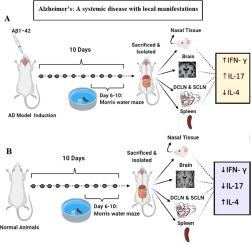International Immunopharmacology ( IF 5.6 ) Pub Date : 2020-12-28 , DOI: 10.1016/j.intimp.2020.107306 Nafiseh Pakravan , Ardeshir Abbasi , Erfan Basirat , Danial Dehghan , Sanaz Heydari Havadaragh

|
The brain has special importance and is known as immune privileged site to and from which trafficking of immune cells is tightly regulated. However, in Alzheimer's disease (AD) the balance of the immune system is disturbed and damages the brain. Given the anatomical and immunological barriers in the brain, we attempted to evaluate if the neuroinflammation occurred in AD is limited to the brain or is expanded to the periphery. Hence, rat model of AD was induced by intra-hippocampal injection of beta-amyloid1-42. Then, nasal, brain, cervical lymph nodes, and spleen were isolated. Then, profile of T-helper (Th)1, Th2, and Th17, represented by IFN-γ, IL-4, and IL-17, respectively, was determined. The results were compared between the organs and with the corresponding tissue in normal animals. IFN-γ and IL-17 levels in the brain, nasal tissue, and cervical lymph nodes of AD model were higher than IL-4, comparing with normal animals. Similar profile was observed in the spleen. The results suggest Alzheimer's as a systemic disease whose complication are observed locally. The possibility of epitope spreading and autoimmune nature of AD is raised again. Interestingly, although AD model was induced by injection of beta-amyloid in the brain, the cellular responses in the brain and nasal tissue were similar indicating that the nasal-brain axis is two-sided. In addition, both of IFN-γ/IL-17 and IL-4/IL-17 ratios, just in nasal tissue were markedly decreased in AD model comparing with normal animals. This suggests development of future nasal-based diagnostic approaches.
中文翻译:

阿尔茨海默氏症的脑,鼻,脾和颈淋巴结组织中T细胞谱的和谐:具有局部表现的全身性疾病
大脑具有特别重要的意义,被称为免疫特权站点,免疫细胞的运输受到严格控制。但是,在阿尔茨海默氏病(AD)中,免疫系统的平衡受到干扰并损害了大脑。考虑到大脑的解剖学和免疫学障碍,我们试图评估AD中发生的神经炎症是否仅限于大脑或扩展到周围。因此,海马内注射β-淀粉样蛋白1-42可诱发AD模型。然后,分离鼻,脑,颈淋巴结和脾脏。然后,确定分别由IFN-γ,IL-4和IL-17表示的T辅助物(Th)1,Th2和Th17的概况。将结果与正常动物的器官以及相应的组织进行了比较。与正常动物相比,AD模型的脑,鼻组织和颈淋巴结中的IFN-γ和IL-17水平高于IL-4。在脾脏中观察到相似的轮廓。结果表明,阿尔茨海默氏病是一种全身性疾病,其并发症在局部观察到。表位扩散和AD自身免疫性质的可能性再次提高。有趣的是,尽管通过在大脑中注射β-淀粉样蛋白诱导了AD模型,但大脑和鼻腔组织中的细胞反应却相似,表明鼻脑轴是两侧的。另外,与正常动物相比,AD模型中仅在鼻组织中的IFN-γ/ IL-17和IL-4 / IL-17比率均显着降低。这暗示了未来基于鼻的诊断方法的发展。


























 京公网安备 11010802027423号
京公网安备 11010802027423号